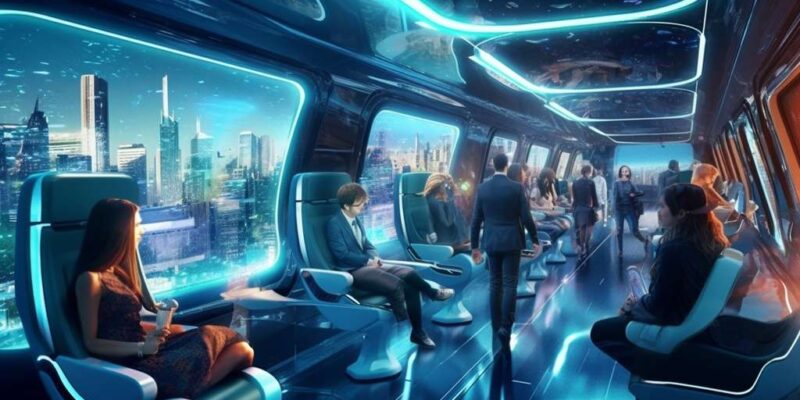
Introduction
The landscape of transportation is undergoing a revolutionary transformation, driven by cutting-edge technologies that promise to reshape the way we move from one place to another. From electric vehicles to autonomous transportation systems, the future of travel is marked by innovation, sustainability, and efficiency. In this exploration, we delve into the latest tech trends that are shaping the future of transportation, offering insights into the advancements that are poised to redefine the way we commute, travel, and connect.
I. Electric Mobility Revolution
A. Electric Vehicles (EVs)
- Growing Popularity and Adoption Rates:
- The electric mobility revolution has gained significant momentum in recent years, with an increasing number of consumers opting for electric vehicles. Advancements in battery technology have extended the range of EVs, making them more practical for daily use.
- Infrastructure Development:
- Governments and private entities are investing heavily in charging infrastructure to address range anxiety and facilitate widespread EV adoption. Fast-charging stations are becoming more prevalent, allowing for quicker and more convenient charging experiences.
- Advancements in Battery Technology:
- Ongoing research in battery technology is driving improvements in energy density, charging speed, and overall performance. Solid-state batteries and other innovations hold the promise of longer ranges and faster charging times, addressing key barriers to EV adoption.
B. Flying Electric Vehicles (eVTOLs)
- Urban Air Mobility (UAM):
- The concept of flying cars has transitioned from science fiction to reality with the development of electric vertical take-off and landing (eVTOL) vehicles. UAM aims to alleviate urban congestion by introducing aerial mobility solutions for short-distance travel.
- Prototypes and Test Flights:
- Companies like Joby Aviation, Lilium, and Vertical Aerospace are actively testing eVTOL prototypes. These vehicles promise to revolutionize urban transportation, providing a faster and more direct means of commuting within cities.
II. Autonomous Transportation
A. Self-Driving Cars
- Advancements in AI and Machine Learning:
- Autonomous vehicles are making significant strides, thanks to advancements in artificial intelligence (AI) and machine learning. These technologies enable vehicles to interpret and respond to complex traffic scenarios, improving safety and efficiency.
- Real-world Testing and Deployment:
- Companies such as Waymo, Tesla, and Uber are conducting real-world tests and deploying fleets of self-driving cars. The gradual introduction of autonomous features, like advanced driver-assistance systems (ADAS), is paving the way for full autonomy.
- Regulatory Challenges and Ethics:
- The widespread adoption of autonomous vehicles faces regulatory challenges and ethical considerations. Policymakers and industry stakeholders are working to establish guidelines for safe deployment and address ethical dilemmas related to decision-making algorithms.
B. Autonomous Public Transportation
- Smart Cities and Connected Infrastructure:
- Autonomous public transportation systems are being developed to enhance the efficiency of urban mobility. Smart city initiatives integrate connected infrastructure, allowing autonomous buses and shuttles to navigate routes seamlessly.
- First-mile/Last-mile Solutions:
- Autonomous shuttles and buses are seen as solutions to the first-mile/last-mile challenge in public transportation. By providing convenient and efficient connectivity to major transit hubs, these systems improve overall accessibility.
III. Hyperloop and High-Speed Rail
A. Hyperloop Technology
- Hyperloop Prototypes and Testing:
- Hyperloop technology, envisioned by Elon Musk, aims to revolutionize long-distance travel by propelling passenger pods through low-pressure tubes at incredible speeds. Companies like Virgin Hyperloop and SpaceX are actively testing prototypes.
- Reduced Travel Times and Sustainability:
- Hyperloop systems have the potential to dramatically reduce travel times between cities. The low-friction environment and energy-efficient design contribute to the sustainability of this transportation mode.
B. High-Speed Rail
- Global Expansion of High-Speed Rail Networks:
- High-speed rail networks are expanding globally, connecting major cities and reducing travel times. Countries like Japan, China, and several European nations have well-established high-speed rail systems, and others are investing in their development.
- Maglev Technology:
- Magnetic levitation (maglev) technology is being explored for high-speed rail, offering the potential for even greater speeds. Maglev trains use magnetic fields to lift and propel the train, minimizing friction and allowing for smoother, faster travel.
IV. Mobility as a Service (MaaS)
A. Integrated Transportation Platforms
- Seamless Multimodal Journeys:
- Mobility as a Service (MaaS) platforms aim to provide users with seamless, end-to-end travel experiences. These platforms integrate various modes of transportation, including ride-sharing, public transit, and bike-sharing, into a single, user-friendly interface.
- Data-Driven Decision Making:
- MaaS relies on data analytics and real-time information to optimize transportation routes and options. Users can access personalized travel recommendations, reducing reliance on personal vehicles and promoting more sustainable modes of transportation.
B. Subscription-Based Models
- Shift from Ownership to Access:
- Subscription-based models for transportation services are gaining traction, encouraging a shift from vehicle ownership to access-based models. Users pay a recurring fee for access to a range of transportation services, promoting flexibility and cost-effectiveness.
- Environmental Sustainability:
- By encouraging shared mobility and reducing the overall number of vehicles on the road, subscription-based models contribute to environmental sustainability. This shift aligns with a broader movement towards greener and more eco-friendly transportation solutions.
V. Environmental Sustainability and Green Initiatives
A. Sustainable Fuels and Energy Sources
- Hydrogen-Powered Vehicles:
- Hydrogen fuel cell technology is being explored as a clean energy source for transportation. Hydrogen-powered vehicles emit only water vapor, offering a zero-emission alternative to traditional combustion engines.
- Renewable Energy Charging Infrastructure:
- The integration of renewable energy sources into charging infrastructure is crucial for the environmental sustainability of electric vehicles. Solar-powered charging stations and smart grids enhance the overall eco-friendliness of electric mobility.
B. Carbon-Neutral Initiatives
- Carbon Offsetting and Emission Reduction:
- Transportation companies and governments are increasingly adopting carbon-neutral initiatives. These efforts include carbon offsetting programs and investments in technologies that reduce emissions, contributing to global sustainability goals.
- Circular Economy Practices:
- The adoption of circular economy practices involves recycling and repurposing materials to reduce waste in the transportation industry. From manufacturing processes to end-of-life vehicle disposal, circular economy principles are being integrated to minimize environmental impact.
VI. Challenges and Considerations
A. Regulatory Frameworks and Standards
- International Coordination:
- The global nature of transportation technologies requires international coordination for regulatory frameworks and standards. Harmonizing regulations ensures the safe and efficient deployment of emerging technologies.
- Data Security and Privacy:
- As transportation becomes more connected and data-driven, ensuring the security and privacy of user information is a paramount concern. Robust cybersecurity measures and transparent data practices are essential for building trust among users.
B. Infrastructure Development
- Investment in Smart Infrastructure:
- The successful implementation of many transportation technologies relies on the development of smart infrastructure. Governments and private entities must invest in intelligent transportation systems, including 5G connectivity and IoT devices.
Source : https://sites.google.com/site/bestessaywritingservicereview/











